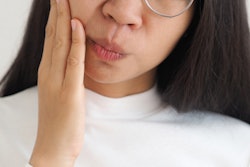
In 2018, I treated a patient with jaw pain -- but something was more serious. Jonathan had a root canal procedure performed on his upper right molar about three months before I saw him. His general dentist performed the root canal and placed a crown on that tooth. Then, Jonathan began to have severe pain in that tooth, in his jaw muscles, and in his jaw joint.
At first, Jonathan thought the root canal was failing and was the cause of his pain. That was part of his problem. The other immediate cause was related to his biting pressure on that newly crowned tooth, which Jonathan didn't consider.
When I saw him on an emergency visit, I needed to get him out of pain. I also had to determine a definitive treatment plan to resolve his issue for good. I treated the emergency problem that day; the other was definitively treated later in the week.
The skinny on jaw pain
 Dr. Alvin Danenberg.
Dr. Alvin Danenberg.As a periodontist, I frequently treated jaw pain. Most pain comes from the jaw joint and the muscles that help chew food. This jaw pain may be called temporomandibular joint (TMJ) pain or temporomandibular disorder (TMD). Many of the causes of this type of jaw pain also can damage the jawbone around the roots of teeth.
More than 40% of adults experience pain in their mouth annually, according to the U.S. Centers for Disease Control and Prevention (CDC). But only 50% to 60% of people with jaw joint pain will seek treatment. Those who don't get treatment continue to live with painful side effects.
The most frequent complaint I have heard is pain either in the jaw joint or in the jaw muscles. Another common symptom is discomfort when opening the jaw, most obviously when eating or speaking. Popping and cracking sounds in the jaw joints when opening and closing may be present. Also, buzzing or ringing sounds in the ears are possible. Sometimes there is swelling; most of the time swelling is not obvious. Pain also can be isolated to the areas around the roots of the teeth.
10 causes of jaw pain
TMD is multifactorial, and there may be sources that are difficult to identify. Below are 10 related causes for TMD:
- Trauma (like a car accident) involving the jaw joint could damage the structures of the joint, resulting in pain.
- Habits of clenching and grinding the teeth can damage the jaw joint and cause muscle pain. These habits also wiggle the roots of the teeth in the jawbone, which will damage the bone around the teeth and may cause tooth pain and cause the tooth to feel loose. Grinding also may crack teeth.
- Improperly designed chewing surfaces because of a poorly shaped crown or a poorly placed filling material could cause forces that rock a tooth from side to side. The rocking motion can cause spasms in the jaw muscles as well as cause a hairline crack to develop in the root of the tooth. This also can cause the involved teeth to feel loose in the jawbone.
- Poor nutrition and unhealthy digestion could cause chronic systemic inflammation that can affect all joints (e.g., rheumatoid arthritis).
- Emotional stress has been shown to create biochemical changes in the blood system that could increase chronic inflammation throughout the body and joints.
- Lack of sleep increases chronic systemic inflammation and can affect joints in the body.
- Excessive estrogen may increase inflammation and damage in the jaw joint.
- Infection beginning in the joint will cause swelling and pain.
- Infection in the jawbone from a failing root canal filling, from residual infection in an extraction site, from an abscessed tooth or a decayed tooth, and from other areas of infection in the mouth and head can affect the TMJ.
- Complications with airway space because of a narrow jaw, improper position of the tongue, and misalignment of teeth can create obstructive breathing and poor oxygenation, which can result in clenching, teeth grinding, and jaw pain.
Treatment options for jaw pain
First, the most obvious potential causes must be addressed. If the bite is causing muscle and jaw soreness, then the bite must be adjusted. Correcting heavy pressures on the chewing surfaces of the teeth by selectively smoothing out these heavy pressure areas may be all that is necessary to make the bite healthy and stop the pain.
If a patient grinds his or her teeth habitually, sometimes a bite guard could be worn during sleep to reduce the pressures in the jaw joint. If people go to the gym and perform strenuous workouts, they often clench. This also would be a good time to wear a bite guard to protect the teeth and jaw joint.
At other times, orthodontic treatment might be necessary to correct the bite. In more complicated cases, the upper and lower arch may be too narrow to allow the tongue to fit comfortably between the lower teeth. In this case, the upper and lower jaw arches could be widened, the teeth properly positioned, and the tongue given more comfortable space. These efforts will open a compromised airway space regaining normal function for the tongue, improved oxygenation, and reduced bruxism.
I published an article titled "Shoddy Dentistry & Mouth Splinters" that describes many dental issues that could cause dental pain and inflammation. Examples include emotional stress and lack of sleep, which have been reported to aggravate the symptoms of TMD.
Based on published research papers, these other therapeutic steps should be considered:
- Treat any obvious or not-so-obvious infections or inflammation in the mouth.
- Reduce stress.
- Get restorative sleep.
- Eat a nutrient-dense, anti-inflammatory diet.
- Avoid eating foods that contain chemicals that can affect the gut and create chronic systemic inflammation.
- Seek the advice of a myofunctional therapist and an orthodontist who are trained in proper jaw structure and function.
- Consider investigate medications or surgery for TMD -- but only as a last resort.
How I eliminated Jonathan's jaw pain
After analyzing the situation, it was clear Jonathan's jaw pain was related to his bite after his crown was made and a hairline crack in the root of his upper molar root canal tooth.
The crown was improperly designed and shaped poorly. The chewing surfaces between that tooth and his lower molar were bumping too hard. Because these pressures were too heavy, his jaw muscles went into spasm, which in turn caused his jaw pain initially.
Jonathan couldn't make this pain go away and didn't know what was causing it. He also could not tell if the upper crowned tooth was hurting more than the lower molar tooth, which was also being pounded with heavy biting forces.
In addition, the heavy pounding pressures on the crowned tooth eventually caused a hairline crack in the roots of that molar. A root canal tooth tends to be more brittle and prone to root fracture. The hairline fracture went through the roots of the upper molar into the jawbone.
At first, I needed to get Jonathan out of pain. The first thing I did was determine the spots on the crown that were hitting his lower molar too hard. I used a very thin "carbon paper" to visualize the responsible heavy pressure points. I then evened out these heavy contacts by smoothing and polishing the chewing surfaces so that his teeth came together properly. Immediately, he noticed his jaw was more comfortable.
Next, I rescheduled Jonathan to extract the upper molar. Once there is a crack in the root that travels up the root into the jawbone, it is not treatable. After I extracted the tooth and prepared the bone socket to receive an implant, Jonathan scheduled to have me place a zirconia-type implant into the socket about a month after the extraction. At times, a bone graft and other bone rebuilding procedures are required to restore the bone socket to receive an implant.
Dr. Alvin Danenberg has retired from the private practice of periodontics in Bluffton, SC. He continues to be on the faculty of the College of Integrative Medicine and created its integrative periodontal teaching module. He also spent two years as chief of periodontics at Charleston Air Force Base earlier in his career. His website is drdanenberg.com.



















